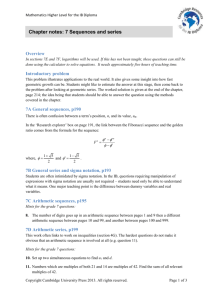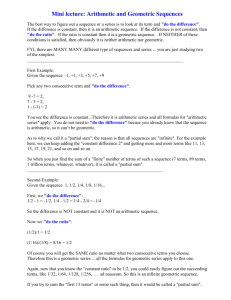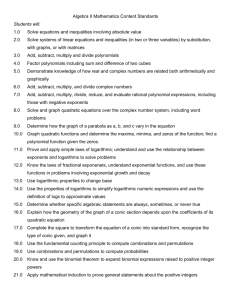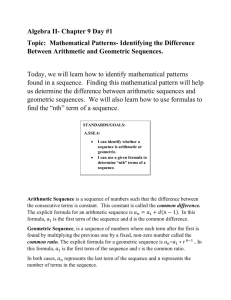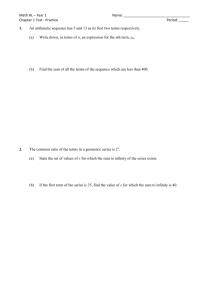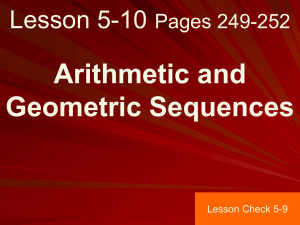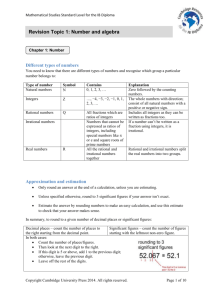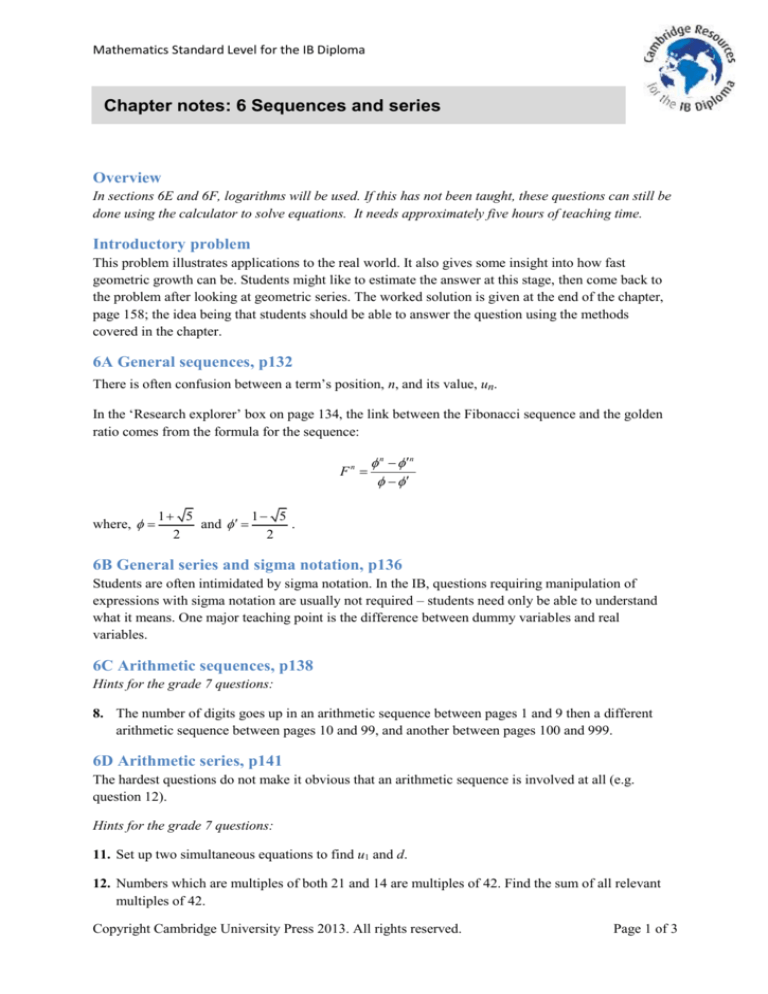
Mathematics Standard Level for the IB Diploma
Chapter notes: 6 Sequences and series
Overview
In sections 6E and 6F, logarithms will be used. If this has not been taught, these questions can still be
done using the calculator to solve equations. It needs approximately five hours of teaching time.
Introductory problem
This problem illustrates applications to the real world. It also gives some insight into how fast
geometric growth can be. Students might like to estimate the answer at this stage, then come back to
the problem after looking at geometric series. The worked solution is given at the end of the chapter,
page 158; the idea being that students should be able to answer the question using the methods
covered in the chapter.
6A General sequences, p132
There is often confusion between a term’s position, n, and its value, un.
In the ‘Research explorer’ box on page 134, the link between the Fibonacci sequence and the golden
ratio comes from the formula for the sequence:
Fn
where,
n n
1 5
1 5
and
.
2
2
6B General series and sigma notation, p136
Students are often intimidated by sigma notation. In the IB, questions requiring manipulation of
expressions with sigma notation are usually not required – students need only be able to understand
what it means. One major teaching point is the difference between dummy variables and real
variables.
6C Arithmetic sequences, p138
Hints for the grade 7 questions:
8. The number of digits goes up in an arithmetic sequence between pages 1 and 9 then a different
arithmetic sequence between pages 10 and 99, and another between pages 100 and 999.
6D Arithmetic series, p141
The hardest questions do not make it obvious that an arithmetic sequence is involved at all (e.g.
question 12).
Hints for the grade 7 questions:
11. Set up two simultaneous equations to find u1 and d.
12. Numbers which are multiples of both 21 and 14 are multiples of 42. Find the sum of all relevant
multiples of 42.
Copyright Cambridge University Press 2013. All rights reserved.
Page 1 of 3
Mathematics Standard Level for the IB Diploma
6E Geometric sequences, p144
We recommend that you cover logarithms before looking at this section. Without logarithms,
numerical methods or a GDC will be required.
Hints for the grade 7 questions:
10. Equations can be formed by finding expressions for the common ratios and differences.
11. Consider S1 and S2 to find the first two terms of the arithmetic sequence.
6F Geometric series, p148
In Worked example 6.16, we could also solve the inequality using logarithms, although this is not on
the SL syllabus.
Hints for the grade 7 questions:
6. Use the consecutive sums to find terms.
6G Infinite geometric series, p150
There are many philosophical problems dealing with convergence, of which the most famous are
Zeno’s paradoxes.
In the ‘Theory of knowledge issues’ box on page 151, there is reference to different groupings of the
terms of a geometric sequence:
S∞ = a – a + a – a + a – a ...
One grouping suggests:
S∞ = (a – a) + (a – a) + (a – a) ...
= 0 + 0 + 0 ...
=0
Another grouping is:
S∞ = a + (–a + a) + (–a + a) + (–a ...
= a + 0 + 0 + 0 ...
=a
Copyright Cambridge University Press 2013. All rights reserved.
Page 2 of 3
Mathematics Standard Level for the IB Diploma
The grouping which students often find most confusing is when the sequence is rewritten twice,
slightly offset:
S∞ = a – a + a – a + a – a ...
a – a + a – a + a – a ...
S∞ =
Adding these together we get:
2S∞ = a + 0 + 0 + 0 ...
So,
S∞ =
a
2
This highlights the danger of doing something as simple as grouping with infinite series.
Hints for the grade 7 questions:
11. You may like to use a graph to determine when 2x is less than 1.
6H Mixed questions on sequences and series, p155
The new syllabus has a greater emphasis on applications, so you might expect to see more questions
of this style.
Hints for the grade 7 questions:
7. There are two geometric series here – the heights on the way up and on the way down. You may
want to treat them separately.
8. Students should recognise the result in (a) as a geometric series.
Copyright Cambridge University Press 2013. All rights reserved.
Page 3 of 3

